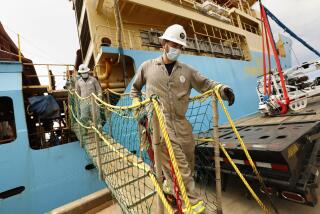Japanese Have a Thirst for Hawaiian Deep-Sea Water
- Share via
Known for its $30-a-pound Kona coffee beans, posh $1,000-a-night hotel suites and $1-million ocean-view condos, the west coast of Hawaii’s Big Island is now cashing in with another pricey offering: $6 bottled water from the bottom of the ocean.
Desalinated deep-sea water from Kona is the state’s fastest-growing export, with demand soaring in Japan. Super-cold water sucked up from thousands of feet below the Pacific Ocean’s surface is being marketed as healthful, pure, mineral-rich drinking water.
Koyo USA Corp. is producing more than 200,000 bottles a day and says it can’t keep up with demand in Japan, where it sells 1.5-liter bottles of its MaHaLo brand for $4 to $6 each.
“We couldn’t ask for better sales,” spokesman John Frosted said. “At this point, we can’t make enough.”
Four other companies hope to cash in on the deep-sea water fad, and so does the state, which collects royalties and rent from the bottlers based at the state Natural Energy Laboratory of Hawaii Authority (NELHA) property next to the Big Island’s Kona International Airport.
The state pumps the chilly water from 2,000 feet beneath the sea, and the companies pay a few cents per bottle to use the official NELHA logo, certifying that the deep-sea water was collected at the state facility.
Koyo, the only company currently selling the deep-sea water from Hawaii, is expanding its plant and has applied to sell the water in the United States, where it will sell for much less than in Japan.
In addition to Koyo, Asia’s thirst for Hawaiian seawater also has attracted Los Angeles-based Deep Sea Water International; Japanese-owned Enzamin USA and Hawaii Deep Marine Inc.; and South Korean-owned Savers Holdings Ltd.
Yoshiyuki Furuno, general manager of Enzamin USA, said Hawaiian products had strong brand recognition in Japan for being high-quality and pure.
“Japanese people have a very good image of Hawaii as a beautiful place with azure skies, clear seas and gentle breeze,” he said.
Savers general manager Guy Toyama said bottled seawater had been around in Japan since the mid-1990s but it could not match the depth, quality and purity of the water from the middle of the Pacific.
Savers plans to begin production this month and will sell its water primarily in South Korea before expanding to China and the U.S. Its 2-liter bottles will retail for about $4 and half-liter bottles for about $2.
Koyo claims that deep-sea water contains ionized sodium, ionized chlorine, magnesium and calcium, which can help with everything from circulation to metabolism. The depth also protects the water from modern contaminants from industry, farming and humans, the company said on its website.
Koyo’s 100,000-square-foot facility features a windowless factory filled with modern stainless-steel machinery, conveyer belts and pipes.
Light-blue plastic bottles are blown and stacked by a robotic arm before being rinsed, filled, capped and labeled. The bottles are then taken to a large room where employees wearing face masks and hairnets inspect them for loose caps, misplaced labels and damage.
“This is a sterile, phenomenally modern, robotic, well-run place,” said former NELHA Executive Director Jeff Smith, interviewed before he left NELHA last month.
When Smith was first approached three years ago by a company that wanted to bottle and sell ocean water, he thought it was a joke. Now, government and business leaders from around the world have visited NELHA to study the deep-sea water bottling phenomenon.
“Many people have said, ‘Hey Jeff, that’s a fad.’ I’m thinking, so was the car,” he said. “People need water.”
Smith, who has left NELHA to work for Deep Sea Water International, said the bottlers had diversified Hawaii’s tourism-dependent economy.
“No matter what the tourism industry does, these guys will keep running,” he said.
Mark Anderson of the state’s Foreign-Trade Zone Division said Hawaii always had difficulty creating new export industries because Asia and the West Coast had more resources and cheaper labor. Now Hawaii may have an inexhaustible gold mine.
“There’s a lot of water out there,” Anderson said. “I don’t think they’re going to run out.”
More to Read
Inside the business of entertainment
The Wide Shot brings you news, analysis and insights on everything from streaming wars to production — and what it all means for the future.
You may occasionally receive promotional content from the Los Angeles Times.










